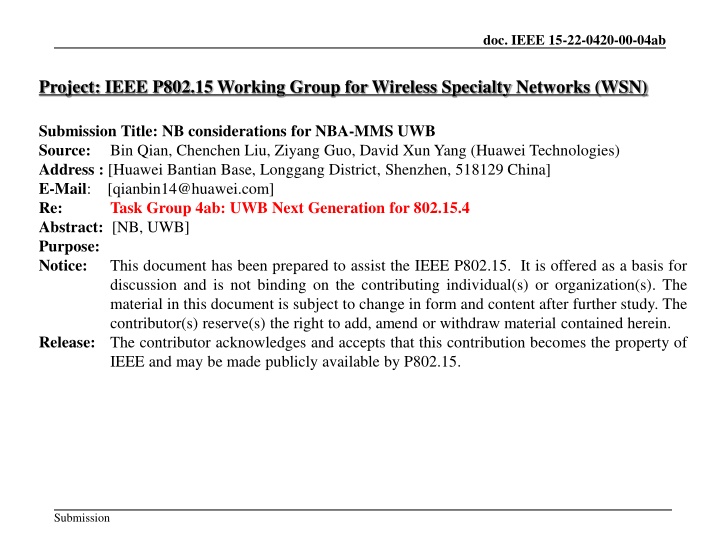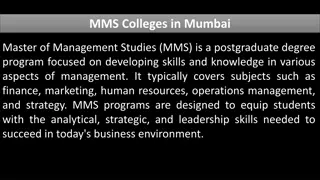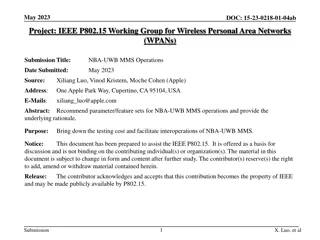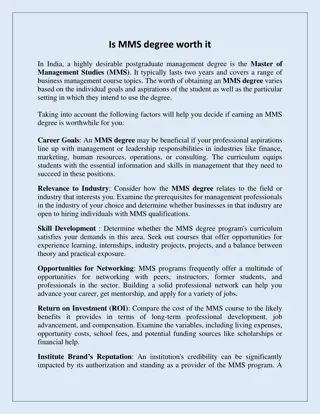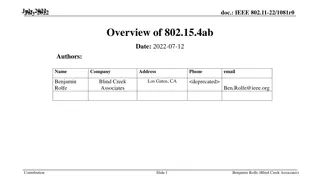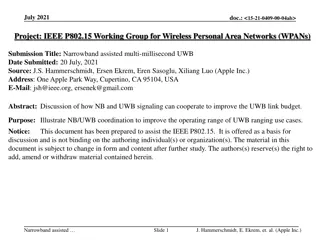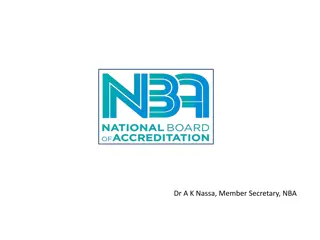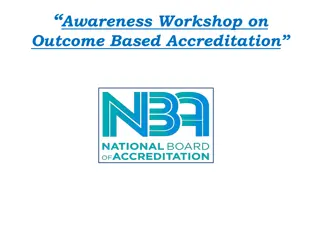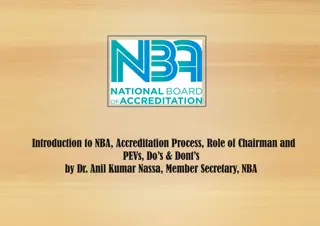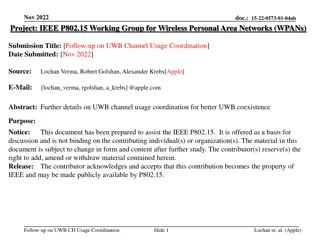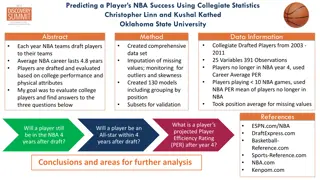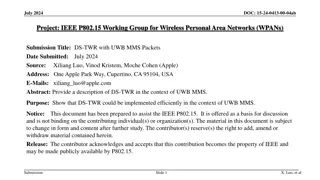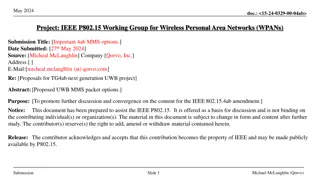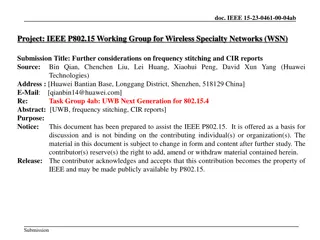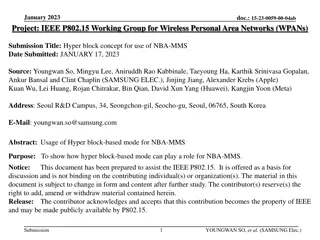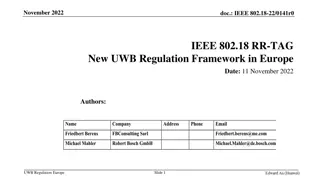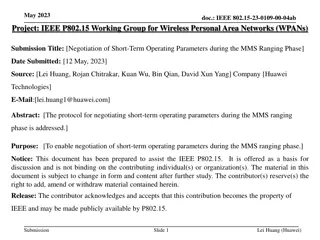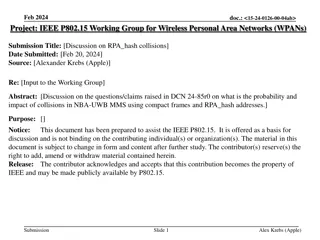NB Considerations for NBA-MMS UWB Source by Huawei Technologies
This document outlines NB considerations for NBA-MMS UWB, addressing interference mitigation, coexistence improvement, and enhanced link budget. It proposes solutions for improved accuracy, reduced complexity, and power consumption, along with enhancements for high-throughput data use cases. The submission covers symbol-to-chip mapping, frequency hopping methods, native discovery mechanisms, and support for various communication protocols.
Download Presentation

Please find below an Image/Link to download the presentation.
The content on the website is provided AS IS for your information and personal use only. It may not be sold, licensed, or shared on other websites without obtaining consent from the author.If you encounter any issues during the download, it is possible that the publisher has removed the file from their server.
You are allowed to download the files provided on this website for personal or commercial use, subject to the condition that they are used lawfully. All files are the property of their respective owners.
The content on the website is provided AS IS for your information and personal use only. It may not be sold, licensed, or shared on other websites without obtaining consent from the author.
E N D
Presentation Transcript
doc. IEEE 15-22-0420-00-04ab Project: IEEE P802.15 Working Group for Wireless Specialty Networks (WSN) Submission Title: NB considerations for NBA-MMS UWB Source: Bin Qian, Chenchen Liu, Ziyang Guo, David Xun Yang (Huawei Technologies) Address : [Huawei Bantian Base, Longgang District, Shenzhen, 518129 China] E-Mail: [qianbin14@huawei.com] Re: Task Group 4ab: UWB Next Generation for 802.15.4 Abstract: [NB, UWB] Purpose: Notice: This document has been prepared to assist the IEEE P802.15. It is offered as a basis for discussion and is not binding on the contributing individual(s) or organization(s). The material in this document is subject to change in form and content after further study. The contributor(s) reserve(s) the right to add, amend or withdraw material contained herein. Release: The contributor acknowledges and accepts that this contribution becomes the property of IEEE and may be made publicly available by P802.15. Submission
Slide 2 doc. IEEE 15-22-0420-00-04ab PAR Objective Safeguards so that the high throughput data use cases will not cause significant disruption to low duty-cycle ranging use cases Interference mitigation techniques to support higher density and higher traffic use cases Other coexistence improvement Backward compatibility with enhanced ranging capable devices (ERDEVs) Improved link budget and/or reduced air-time Proposed Solution (how addressed) Additional channels and operating frequencies Improvements to accuracy / precision / reliability and interoperability for high-integrity ranging Reduced complexity and power consumption 1. Improved symbol-to-chip mapping to achieve better error performance and assist the CFO estimation Hybrid operation with narrowband signaling to assist UWB 2. NB frequency hopping method Enhanced native discovery and connection setup mechanisms Sensing capabilities to support presence detection and environment mapping Low-power low-latency streaming Higher data-rate streaming allowing at least 50 Mbit/s of throughput Support for peer-to-peer, peer-to-multi-peer, and station-to- infrastructure protocols Infrastructure synchronization mechanisms Submission
July 2022 doc. IEEE 15-22-0420-00-04ab NB Symbol-to-chip Mapping Submission Slide 3 Bin Qian, Chenchen Liu, Ziyang Guo, Huawei
July 2022 doc. IEEE 15-22-0420-00-04ab Recap of NB NB assisted UWB has been discussed in [1-4] to improve link budget NB provides initial CFO to UWB In [5], the PPDU formats in Clause 12 of IEEE 802.15.4-2020 are recommended as the NB candidate The functional block diagram of O-QPSK is as follows According to the possible data rate, two symbol-to-chip mappings are required - (32, 4) symbol-to-chip mapping - (8, 4) symbol-to-chip mapping Submission Slide 4 Bin Qian, Chenchen Liu, Ziyang Guo, Huawei
July 2022 doc. IEEE 15-22-0420-00-04ab Symbol-to-chip Mapping (32, 4) symbol-to-chip mapping (8, 4) symbol-to-chip mapping Submission Slide 5 Bin Qian, Chenchen Liu, Ziyang Guo, Huawei
July 2022 Autocorrelation Characteristics of Current Mapping doc. IEEE 15-22-0420-00-04ab 1 1 1 1 0.9 0.9 0.9 0.9 0.8 0.8 0.8 0.8 0.7 0.7 0.7 0.7 0.6 0.6 0.6 0.6 0.5 0.5 0.5 0.5 0.4 0.4 0.4 0.4 0.3 0.3 0.3 0.3 0.2 0.2 0.2 0.2 0.1 0.1 0.1 0.1 0 0 0 0 0 20 40 60 80 100 120 0 20 40 60 80 100 120 0 20 40 60 80 100 120 0 20 40 60 80 100 120 1 1 1 1 0.9 0.9 0.9 0.9 0.8 0.8 0.8 0.8 0.7 0.7 0.7 0.7 0.6 0.6 0.6 0.6 0.5 0.5 0.5 0.5 0.4 0.4 0.4 0.4 0.3 0.3 0.3 0.3 0.2 0.2 0.2 0.2 0.1 0.1 0.1 0.1 0 0 0 0 0 20 40 60 80 100 120 0 20 40 60 80 100 120 0 20 40 60 80 100 120 0 20 40 60 80 100 120 1 1 1 1 0.9 0.9 0.9 0.9 0.8 0.8 0.8 0.8 0.7 0.7 0.7 0.7 0.6 0.6 0.6 0.6 0.5 0.5 0.5 0.5 0.4 0.4 0.4 0.4 0.3 0.3 0.3 0.3 0.2 0.2 0.2 0.2 0.1 0.1 0.1 0.1 0 0 0 0 20 40 60 80 100 120 0 20 40 60 80 100 120 0 20 40 60 80 100 120 0 1 1 0 20 40 60 80 100 120 1 1 0.9 0.9 0.9 0.9 0.8 0.8 0.8 0.8 0.7 0.7 0.7 0.7 0.6 0.6 0.6 0.6 0.5 0.5 0.5 0.5 0.4 0.4 0.4 0.4 0.3 0.3 0.3 0.3 0.2 0.2 0.2 0.2 0.1 0.1 0.1 0.1 0 0 0 20 40 60 80 100 120 0 20 40 60 80 100 120 0 0 0 20 40 60 80 100 120 0 20 40 60 80 100 120 O-QPSK modulation; 4x over-sampling (complex domain) Submission Slide 6 Bin Qian, Chenchen Liu, Ziyang Guo, Huawei
July 2022 doc. IEEE 15-22-0420-00-04ab Union Bound The union upper bound of the symbol error rate for the symbol-to-chip mapping under AWGN is given by ? 1 ??= ?????? ?? ?2 ?=???? - ???? is the complementary error function - ? is the signal-to-noise ratio ??is the number of pairs of mapping sequences with Hamming distance ? The symbol error rate mainly depends on the minimum Hamming distance ????and ????? The upper bound of the minimum Hamming distance for symbol-to-chip mapping of size ? with length ? is - ?? ???? 2 ? 1 Submission Slide 7 Bin Qian, Chenchen Liu, Ziyang Guo, Huawei
July 2022 doc. IEEE 15-22-0420-00-04ab Hamming Distance Symbol-to-chip Mapping sequence 1 2 3 4 5 6 7 8 9 10 11 12 13 14 15 16 1 0 16 18 20 20 20 18 16 16 12 14 20 20 20 14 12 2 16 0 16 18 20 20 20 18 12 16 12 14 20 20 20 14 3 18 16 0 16 18 20 20 20 14 12 16 12 14 20 20 20 4 20 18 16 0 16 18 20 20 20 14 12 16 12 14 20 20 5 20 20 18 16 0 16 18 20 20 20 12 12 16 12 14 20 6 20 20 20 18 16 0 16 18 20 20 20 14 12 16 12 14 7 18 20 20 20 18 16 0 16 14 20 20 20 14 12 16 12 8 16 18 20 20 20 18 16 0 12 14 20 20 20 14 12 16 9 16 12 14 20 20 20 14 12 0 16 18 20 20 20 18 16 10 12 16 12 14 20 20 20 14 16 0 16 18 20 20 20 18 11 14 12 16 12 14 20 20 20 18 16 0 16 18 20 20 20 12 20 14 12 16 12 14 20 20 20 18 16 0 16 18 20 20 13 20 20 14 12 16 12 14 20 20 20 18 16 0 16 18 20 14 20 20 20 14 12 16 12 14 20 20 20 18 16 0 16 18 15 14 20 20 20 14 12 16 12 18 20 20 20 18 16 0 16 16 12 14 20 20 20 14 12 16 16 18 20 20 20 18 16 0 The minimum Hamming distance 12 is far from the theoretical upper bound Submission Slide 8 Bin Qian, Chenchen Liu, Ziyang Guo, Huawei
July 2022 doc. IEEE 15-22-0420-00-04ab Symbol-to-chip Option 1 Date symbol Chip Values ??,??, ,??? 0 1 1 1 1 0 1 0 0 0 1 0 0 1 1 0 1 0 1 1 0 0 1 1 1 1 0 1 0 1 0 0 1 1 1 0 0 1 1 1 1 1 0 1 0 0 0 1 0 0 1 1 0 1 0 1 1 0 0 1 1 1 1 0 1 0 2 1 0 1 0 1 0 0 1 1 1 1 1 0 1 0 0 0 1 0 0 1 1 0 1 0 1 1 0 0 1 1 1 3 0 1 1 1 1 0 1 0 1 0 0 1 1 1 1 1 0 1 0 0 0 1 0 0 1 1 0 1 0 1 1 0 4 0 1 1 0 0 1 1 1 1 0 1 0 1 0 0 1 1 1 1 1 0 1 0 0 0 1 0 0 1 1 0 1 5 1 1 0 1 0 1 1 0 0 1 1 1 1 0 1 0 1 0 0 1 1 1 1 1 0 1 0 0 0 1 0 0 6 0 1 0 0 1 1 0 1 0 1 1 0 0 1 1 1 1 0 1 0 1 0 0 1 1 1 1 1 0 1 0 0 7 0 1 0 0 0 1 0 0 1 1 0 1 0 1 1 0 0 1 1 1 1 0 1 0 1 0 0 1 1 1 1 1 8 1 0 1 0 0 0 0 1 0 0 0 1 1 0 0 0 0 0 1 1 0 0 1 0 1 1 1 1 1 1 0 0 9 1 1 0 0 1 0 1 0 0 0 0 1 0 0 0 1 1 0 0 0 0 0 1 1 0 0 1 0 1 1 1 1 10 1 1 1 1 1 1 0 0 1 0 1 0 0 0 0 1 0 0 0 1 1 0 0 0 0 0 1 1 0 0 1 0 11 0 0 1 0 1 1 1 1 1 1 0 0 1 0 1 0 0 0 0 1 0 0 0 1 1 0 0 0 0 0 1 1 12 0 0 1 1 0 0 1 0 1 1 1 1 1 1 0 0 1 0 1 0 0 0 0 1 0 0 0 1 1 0 0 0 13 1 0 0 0 0 0 1 1 0 0 1 0 1 1 1 1 1 1 0 0 1 0 1 0 0 0 0 1 0 0 0 1 14 0 0 0 1 1 0 0 0 0 0 1 1 0 0 1 0 1 1 1 1 1 1 0 0 1 0 1 0 0 0 0 1 15 0 0 0 1 0 0 0 1 1 0 0 0 0 0 1 1 0 0 1 0 1 1 1 1 1 1 0 0 1 0 1 0 Advantages - The Hamming distance of any two 32-chip sequences is either 16 or 18 to improve the symbol error performance - The cyclic shift and element-wise XOR properties are same as the current symbol-to-chip mapping to reduce the complexity of the symbol-to-chip transformation Submission Slide 9 Bin Qian, Chenchen Liu, Ziyang Guo, Huawei
July 2022 Symbol-to-chip Option 1 Hamming Distance doc. IEEE 15-22-0420-00-04ab Hamming distance ?? ?? ?? ?? ?? ?? ?? ?? ?? ?? ??? ??? ??? ??? ??? ??? ?? 0 16 18 18 16 18 18 16 16 16 18 18 16 18 18 16 ?? 16 0 16 18 18 16 18 18 16 16 16 18 18 16 18 18 ?? 18 16 0 16 18 18 16 18 18 16 16 16 18 18 16 18 ?? 18 18 16 0 16 18 18 16 18 18 16 16 16 18 18 16 ?? 16 18 18 16 0 16 18 18 16 18 18 16 16 16 18 18 ?? 18 16 18 18 16 0 16 18 18 16 18 18 16 16 16 18 ?? 18 18 16 18 18 16 0 16 18 18 16 18 18 16 16 16 ?? 16 18 18 16 18 18 16 0 16 18 18 16 18 18 16 16 ?? 16 16 18 18 16 18 18 16 0 16 18 18 16 18 18 16 ?? 16 16 16 18 18 16 18 18 16 0 16 18 18 16 18 18 ??? 18 16 16 16 18 18 16 18 18 16 0 16 18 18 16 18 ??? 18 18 16 16 16 18 18 16 18 18 16 0 16 18 18 16 ??? 16 18 18 16 16 16 18 18 16 18 18 16 0 16 18 18 ??? 18 16 18 18 16 16 16 18 18 16 18 18 16 0 16 18 ??? 18 18 16 18 18 16 16 16 18 18 16 18 18 16 0 16 ??? 16 18 18 16 18 18 16 16 16 18 18 16 18 18 16 0 Submission Slide 10 Bin Qian, Chenchen Liu, Ziyang Guo, Huawei
July 2022 doc. IEEE 15-22-0420-00-04ab Symbol-to-chip Option 2 Date symbol Chip Values ??,??, ,??? 0 1 0 0 1 1 1 0 1 0 1 1 0 0 0 1 1 0 0 0 1 0 1 0 0 0 1 0 0 0 1 0 0 1 1 0 1 0 1 0 1 1 0 1 1 1 1 1 1 1 1 0 0 1 0 0 1 0 1 1 1 1 1 0 0 1 2 1 1 1 1 0 0 1 0 1 0 1 0 1 1 0 1 1 1 1 1 1 1 1 0 0 1 0 0 1 0 1 1 3 0 1 1 1 1 0 0 1 0 1 0 1 0 1 1 0 1 1 1 1 1 1 1 1 0 0 1 0 0 1 0 1 4 1 0 1 0 1 1 1 1 1 0 0 1 0 1 0 1 0 1 1 0 1 1 1 1 1 1 1 1 0 0 1 0 5 1 1 0 0 0 0 0 1 0 0 0 0 1 0 0 1 0 0 1 0 0 1 1 1 0 0 1 0 1 1 1 0 6 1 0 1 0 0 0 0 0 1 0 0 0 0 1 0 0 1 0 0 1 0 0 1 1 1 0 0 1 0 1 1 1 7 1 0 1 1 1 0 1 0 0 0 0 0 1 0 0 0 0 1 0 0 1 0 0 1 0 0 1 1 1 0 0 1 8 0 1 1 0 0 1 0 1 1 1 0 1 0 0 0 0 0 1 0 0 0 0 1 0 0 1 0 0 1 0 0 1 9 0 0 0 1 0 1 0 0 0 1 1 1 1 0 0 0 1 0 0 0 1 1 1 1 1 1 1 0 0 0 1 1 10 0 1 0 1 0 0 1 1 1 1 0 0 1 1 0 0 1 1 0 0 0 1 0 0 1 1 1 1 0 1 0 0 11 0 0 1 0 0 1 0 0 0 1 1 0 1 1 1 0 0 1 1 0 1 1 1 0 1 0 0 1 1 1 0 0 12 1 1 0 1 1 1 0 0 1 1 0 1 1 1 0 1 0 0 1 1 1 0 0 0 1 0 0 1 0 0 0 1 13 0 0 0 0 0 0 1 1 1 0 1 1 0 0 1 0 0 0 1 1 1 0 0 0 0 0 0 1 1 0 1 0 14 0 1 0 1 1 0 0 0 0 0 1 1 0 1 1 1 1 1 0 0 0 1 0 1 1 0 0 1 1 0 1 0 15 0 1 1 0 1 1 0 0 1 1 0 0 1 0 1 1 1 1 0 1 1 0 0 1 1 1 1 0 1 1 1 0 Advantages - The minimum Hamming distance of any two 32-chip sequences is 16 - Better weight distribution ?? leads to better symbol error performance Submission Slide 11 Bin Qian, Chenchen Liu, Ziyang Guo, Huawei
July 2022 Symbol-to-chip Option 2 Hamming Distance doc. IEEE 15-22-0420-00-04ab Hamming distance ?? ?? ?? ?? ?? ?? ?? ?? ?? ?? ??? ??? ??? ??? ??? ??? ?? 0 16 20 17 20 16 20 20 17 17 17 17 16 17 17 17 ?? 16 0 16 17 16 20 16 16 17 17 17 17 16 17 17 17 ?? 20 16 0 17 16 16 16 16 17 17 17 17 16 17 17 17 ?? 17 17 17 0 17 17 17 17 16 16 16 16 17 20 16 16 ?? 20 16 16 17 0 16 16 16 17 17 17 17 16 17 17 17 ?? 16 20 16 17 16 0 16 16 17 17 17 17 20 17 17 17 ?? 20 16 16 17 16 16 0 16 17 17 17 17 16 17 17 17 ?? 20 16 16 17 16 16 16 0 17 17 17 17 16 17 17 17 ?? 17 17 17 16 17 17 17 17 0 16 16 16 17 16 20 16 ?? 17 17 17 16 17 17 17 17 16 0 16 16 17 20 16 16 ??? 17 17 17 16 17 17 17 17 16 16 0 16 17 20 16 16 ??? 17 17 17 16 17 17 17 17 16 16 16 0 17 16 16 16 ??? 16 16 16 17 16 20 16 16 17 17 17 17 0 17 17 17 ??? 17 17 17 20 17 17 17 17 16 20 20 16 17 0 16 20 ??? 17 17 17 16 17 17 17 17 20 16 16 16 17 16 0 16 ??? 17 17 17 16 17 17 17 17 16 16 16 16 17 20 16 0 Submission Slide 12 Bin Qian, Chenchen Liu, Ziyang Guo, Huawei
July 2022 doc. IEEE 15-22-0420-00-04ab Symbol-to-chip Option 3 Date symbol Chip Values ??,??, ,??? 0 1 1 0 0 1 0 1 0 1 0 0 1 0 0 0 0 1 1 0 0 1 0 1 0 0 1 1 0 1 1 1 1 1 1 0 1 0 1 1 0 0 1 1 1 1 0 1 1 0 1 0 1 0 1 1 0 0 0 0 0 0 1 0 0 1 2 1 0 0 1 0 0 0 0 1 1 0 0 1 0 1 0 1 0 0 1 0 0 0 0 0 0 1 1 0 1 0 1 3 1 1 1 1 0 1 1 0 1 0 1 0 1 1 0 0 1 1 1 1 0 1 1 0 0 1 0 1 0 0 1 1 4 1 0 0 1 1 1 1 1 0 0 1 1 1 0 1 0 1 0 0 1 1 1 1 1 1 1 0 0 0 1 0 1 5 1 1 1 1 1 0 0 1 0 1 0 1 1 1 0 0 1 1 1 1 1 0 0 1 1 0 1 0 0 0 1 1 6 1 1 0 0 0 1 0 1 0 1 1 0 0 0 0 0 1 1 0 0 0 1 0 1 1 0 0 1 1 1 1 1 7 1 0 1 0 0 0 1 1 0 0 0 0 0 1 1 0 1 0 1 0 0 0 1 1 1 1 1 1 1 0 0 1 8 1 0 0 1 1 1 1 1 1 1 0 0 0 1 0 1 0 1 1 0 0 0 0 0 1 1 0 0 0 1 0 1 9 1 1 1 1 1 0 0 1 1 0 1 0 0 0 1 1 0 0 0 0 0 1 1 0 1 0 1 0 0 0 1 1 10 1 1 0 0 0 1 0 1 1 0 0 1 1 1 1 1 0 0 1 1 1 0 1 0 1 0 0 1 1 1 1 1 11 1 0 1 0 0 0 1 1 1 1 1 1 1 0 0 1 0 1 0 1 1 1 0 0 1 1 1 1 1 0 0 1 12 1 1 0 0 1 0 1 0 0 1 1 0 1 1 1 1 0 0 1 1 0 1 0 1 0 1 1 0 1 1 1 1 13 1 0 1 0 1 1 0 0 0 0 0 0 1 0 0 1 0 1 0 1 0 0 1 1 0 0 0 0 1 0 0 1 14 1 0 0 1 0 0 0 0 0 0 1 1 0 1 0 1 0 1 1 0 1 1 1 1 0 0 1 1 0 1 0 1 15 1 1 1 1 0 1 1 0 0 1 0 1 0 0 1 1 0 0 0 0 1 0 0 1 0 1 0 1 0 0 1 1 Recommend Option 3 - The Hamming distance of any two 32-chip sequences is 16 to improve the symbol error rate - There are two chips with the fixed value at the particular positions, which could be used to assist the CFO estimation and compensation - O-QPSK modulated symbols are orthogonal to support non-coherent demodulator - O-QPSK modulated symbols have low PAPR in the frequency domain Submission Slide 13 Bin Qian, Chenchen Liu, Ziyang Guo, Huawei
July 2022 doc. IEEE 15-22-0420-00-04ab Autocorrelation Characteristics of Option 3 1 1 1 1 0.9 0.9 0.9 0.9 0.8 0.8 0.8 0.8 0.7 0.7 0.7 0.7 0.6 0.6 0.6 0.6 0.5 0.5 0.5 0.5 0.4 0.4 0.4 0.4 0.3 0.3 0.3 0.3 0.2 0.2 0.2 0.2 0.1 0.1 0.1 0.1 0 0 0 0 20 40 60 80 100 120 0 0 20 40 60 80 100 120 0 20 40 60 80 100 120 0 20 40 60 80 100 120 1 1 1 1 0.9 0.9 0.9 0.9 0.8 0.8 0.8 0.8 0.7 0.7 0.7 0.7 0.6 0.6 0.6 0.6 0.5 0.5 0.5 0.5 0.4 0.4 0.4 0.4 0.3 0.3 0.3 0.3 0.2 0.2 0.2 0.2 0.1 0.1 0.1 0.1 0 0 0 0 0 20 40 60 80 100 120 0 20 40 60 80 100 120 0 20 40 60 80 100 120 0 20 40 60 80 100 120 1 1 1 1 0.9 0.9 0.9 0.9 0.8 0.8 0.8 0.8 0.7 0.7 0.7 0.7 0.6 0.6 0.6 0.6 0.5 0.5 0.5 0.5 0.4 0.4 0.4 0.4 0.3 0.3 0.3 0.3 0.2 0.2 0.2 0.2 0.1 0.1 0.1 0.1 0 0 0 0 0 20 40 60 80 100 120 0 20 40 60 80 100 120 0 20 40 60 80 100 120 0 20 40 60 80 100 120 1 1 1 1 0.9 0.9 0.9 0.9 0.8 0.8 0.8 0.8 0.7 0.7 0.7 0.7 0.6 0.6 0.6 0.6 0.5 0.5 0.5 0.5 0.4 0.4 0.4 0.4 0.3 0.3 0.3 0.3 0.2 0.2 0.2 0.2 0.1 0.1 0.1 0.1 0 0 0 20 40 60 80 100 120 0 20 40 60 80 100 120 0 0 0 20 40 60 80 100 120 0 20 40 60 80 100 120 O-QPSK modulation; 4x over-sampling (all in real numbers) Submission Slide 14 Bin Qian, Chenchen Liu, Ziyang Guo, Huawei
July 2022 doc. IEEE 15-22-0420-00-04ab Simulation Results Setting A - AWGN without CFO - coherent demodulator with hard decision - 4 samples per chip duration 100 10-1 Symbol Error Rate 10-2 10-3 10-4 Current PN symbol-to-chip mapping Option 1 Option2 Option3 10-5 0 2 4 6 8 10 12 Eb/N0 Option 1, 2, 3 achieve 0.9dB, 0.9dB and 0.6dB gain at SER = 10 4, respectively Submission Slide 15 Bin Qian, Chenchen Liu, Ziyang Guo, Huawei
July 2022 doc. IEEE 15-22-0420-00-04ab Simulation Results Setting B - - - AWGN with CFO = 40 KHz coherent demodulator with hard decision, SKD estimator [1] is applied by preamble 4 samples per chip duration 107 Current PN symbol-to-chip mapping with SKD estimator Option 3 Residual CFO variance (Hz)2 106 105 104 3 4 5 6 7 8 9 10 11 12 Eb/N0 Option 3 can assist CFO estimation such that NB can provide more accuracy CFO to UWB, while option 1 and 2 have same CFO estimation performance as current PN symbol-to-chip mapping [1] Shengchen Dai, et.al , A Robust Demodulator for OQPSK-DSSS System , 2014. [Online] https://link.springer.com/content/pdf/10.1007/s00034-014-9844-z.pdf Submission Slide 16 Bin Qian, Chenchen Liu, Ziyang Guo, Huawei
July 2022 doc. IEEE 15-22-0420-00-04ab NB Frequency Hopping Submission Slide 17 Bin Qian, Chenchen Liu, Ziyang Guo, Huawei
July 2022 doc. IEEE 15-22-0420-00-04ab Recap of NB Frequency Hopping Frequency hopping is recommended for NB transmission to avoid deep fade and interference from other coexisting systems [6] Hop every ranging round/block Submission Slide 18 Bin Qian, Chenchen Liu, Ziyang Guo, Huawei
July 2022 doc. IEEE 15-22-0420-00-04ab Slot Based NB Frequency Hopping MMS ranging phase may last for tens of milliseconds, up to 32ms [3] Hop every ranging round/block may not be a good choice - Channel condition and interference may have changed a lot - NB channel may be occupied when ranging report is sent back Slot based frequency hopping: hop every slot (similar to Bluetooth) - No impact to receiver since hopping timing is known - The duration of one slot could be pre-set, e.g., 1ms Ranging Round 1ms 1ms ... Initiator(TX) Poll Poll ... Report Resp Responder(TX) fy fx MMS ranging phase Use different frequency Submission Slide 19 Bin Qian, Chenchen Liu, Ziyang Guo, Huawei
July 2022 doc. IEEE 15-22-0420-00-04ab Hopping Function Use LFSR to generate pseudo random channel index - [6] proposes reuse AES-128 to generate pseudo random channel index - Compared with AES-128 based channel switching, LFSR based channel switching is more structured, which makes it much easier to analyze the auto/cross-correlation performance in theory Channel_index = hop_function(initial seed, slot index, block list) Initial seed is the starting point of LFSR, which could be determined by the MAC address of the initiator. Initial seed could be transferred by BLE Slot index is monotonically increasing with time Block list is the channel set being interfered, which could be updated to adapt to the environment change Channel index in [0, M-1] log2M binary No Convert to decimal number and mod M in block list? Channel index Initial seed LFSR Yes Submission Slide 20 Bin Qian, Chenchen Liu, Ziyang Guo, Huawei
July 2022 doc. IEEE 15-22-0420-00-04ab Summary 3 different O-QPSK (32, 4) symbol-to-chip mappings are introduced. Option 3 is recommended - The Hamming distance of any two 32-chip sequences is improved from 12 to 16 - It could assist the CFO estimation and compensation Slot based NB frequency hopping is introduced Hop every ranging round/block may not be a good choice A hopping function is proposed Submission Slide 21 Bin Qian, Chenchen Liu, Ziyang Guo, Huawei
July 2022 doc. IEEE 15-22-0420-00-04ab References [1] 15-22-0064-04ab Potentials of narrowband assisted UWB [2] 15-22-0074-04ab Link budget analysis for NBA-MMS [3] 15-21-0593-04ab More on NBA-MMS [4] 15-21-0409-04ab Narrowband assisted multi-millisecond UWB [5] 15-22-0262-04ab NBA-UWB technical framework proposal [6] 15-22-0340-04ab Narrowband channel access and interference mitigation for NBA-MMS-UWB Submission Slide 22 Bin Qian, Chenchen Liu, Ziyang Guo, Huawei
